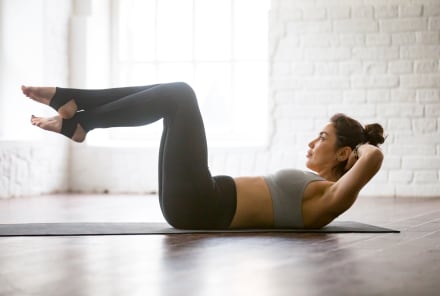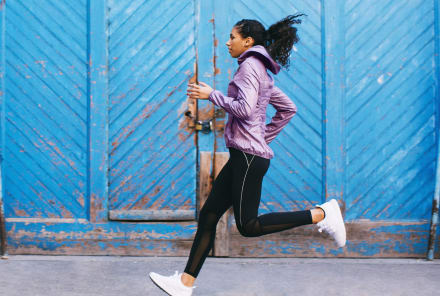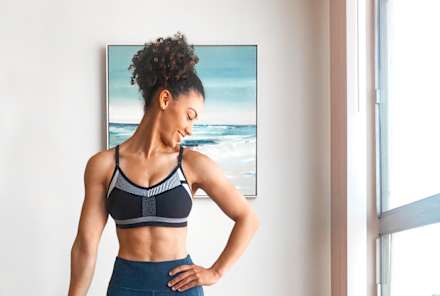Advertisement
6 Partner Yoga Poses You Can Try At Home

Are you looking for a quarantine activity that's more exciting than rewatching your favorite Netflix show? Partner yoga can be a fun way to stay active and engaged with your family or roommates while staying at home. Practicing yoga with another person is a joyful activity that can also be a great tool for deepening emotional connection.
While you're social-distancing, try playing around with a few simple partner yoga poses to strengthen your body, increase flexibility, and connect with your loved ones or housemates all at once. Try some of these poses with your partner, family, or roommates at home:
Partner Twist
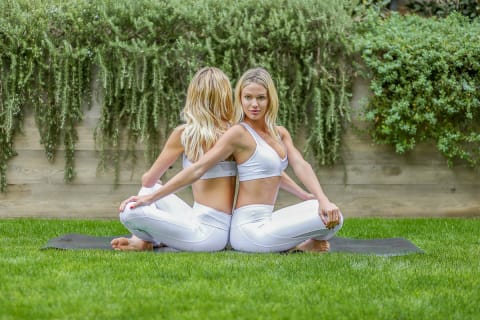
How to: Sit back-to-back with your partner. Take a deep breath, and lengthen your spine. Turn to the right, and place your right hand on your partner's knee. Breathe in at the same time as your partner, and on a coordinated exhale, deepen the twist. Continue this movement for 60 seconds or more.
Partner Forward Fold (Paschimottanasana)
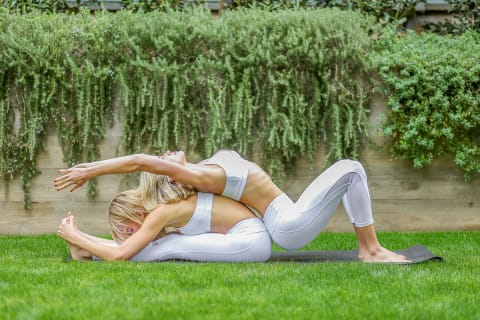
How to: Start with one partner sitting on the ground with their legs straight in front of them. The second partner will sit facing the other direction with their butt up against their partner's. The second partner will then gently lay their back on top of the back of the first partner, listening to them as they note which position is a good stretch and where to stop. Both partners can practice deep breathing throughout. Hold this pose for 30 seconds or more.
Seated Wide-Legged Side Stretch

How to: Start in a straddle position, with legs out wide. Partners should be facing each other, with their feet pressed together. Bend at your torso, and reach toward your left foot. Hold for 30 seconds, then repeat on the opposite side.
Seated Wide-Legged Forward Fold

How to: Start in a straddle position, with legs out wide. Partners should be facing each other, with their feet pressed together. One partner will bend forward at the torso and reach for the top of the other partner's thighs. The other partner will bend forward at the torso and place their hands on top of the other partner's back. Hold for 60 seconds, then switch positions.
Reclined Butterfly Pose
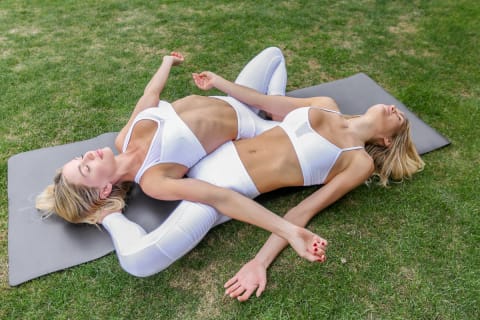
How to: Start by sitting on the ground, next to each other but facing opposite directions. Both partners will bring the soles of their feet together, and allow knees to bend and fall to the side, making a diamond shape. Both partners will lean backward, resting their upper back on the other partner's knee. Allow hands to rest on the sides. Hold for 60 seconds.
Flying
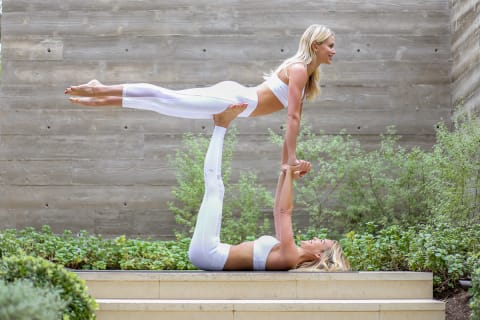
How to: Start with one partner lying on their back with their legs and their arms straight in the air. The other partner will stand facing them. The partners will grab each other's hands and the person lying on the ground will place the soles of their feet at the hips of the person standing. The standing partner will then lean forward slowly until the lying partner is able to balance them completely on top of their legs.
Benefits of partner yoga.
In addition to being a great strength and flexibility challenge, partner yoga cultivates many emotional tools that can carry over into your everyday life, especially during trying times:
Learn how to let go.
When you are practicing partner yoga, the fate of a pose isn't totally in your control. It is something that you must reach through trial, communication, and cooperation. This process requires a release of control, along with vulnerability and trust. Learning these skills on the mat can help you release the notion of control in your life.
Problem-solving.
Partner yoga can be a great exercise in problem-solving and communication. When you're working through a pose, you and your partner must be in constant communication about how to achieve it. You might not always agree, but with a similar goal in mind, you'll likely reach the finish line. Once again, you can apply these problem-solving tools off the mat, too.
Connect with your partner.
Partner yoga requires you to work through problems, let loose, and communicate. Partner yoga can be an excellent tool for deepening emotional connection and communication, especially during difficult times.
Get in touch with your own body.
Coordinating your breath and movements with another person requires you to understand your own breath and body. Learning to listen to your body is an incredible tool that can help you become more energized and happy overall.
The power of play.
This type of practice is fun, playful, and often filled with laughter. It also allows you to try new things without worrying too much about the outcome. Playfulness is an excellent way to deepen connection and to lighten the mood in your household.
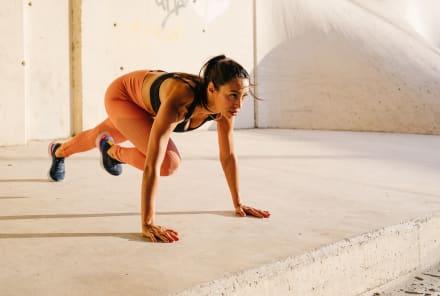
Short On Time? Try This Personal Trainer's 5-Minute Full-Body Workout
Krista Stryker, NSCA-CPT

Short On Time? Try This Personal Trainer's 5-Minute Full-Body Workout
Krista Stryker, NSCA-CPT

Short On Time? Try This Personal Trainer's 5-Minute Full-Body Workout
Krista Stryker, NSCA-CPT

Short On Time? Try This Personal Trainer's 5-Minute Full-Body Workout
Krista Stryker, NSCA-CPT
